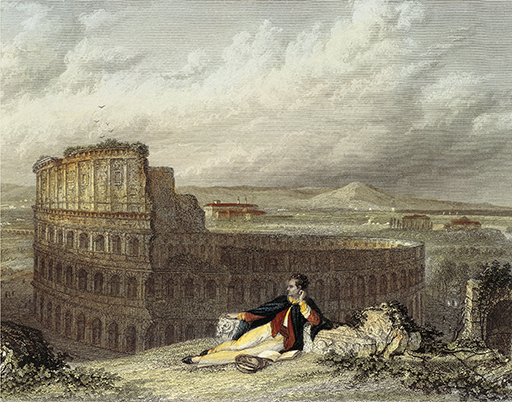3 The poetry of the Grand Tour
This section on English Literature was written by Nicola J. Watson
The young gentlemen who travelled to continental Europe in the eighteenth century in search of an education did not confine themselves to commissioning portraits or bringing back artefacts to adorn their houses; typically, they also wrote letters and journals detailing their experiences. Sometimes, if they had literary pretensions, they would publish these, and in fact the last decades of the eighteenth century saw a proliferation of published ‘Tours’. However, the French Revolutionary and Napoleonic wars closed Europe from 1795 to the British leisure traveller, and it was only in 1815, with the defeat of Napoleon at Waterloo, that a version of the Grand Tour was once again available. This section of the course will focus on a particularly famous piece of travel writing that describes an experience of Rome in 1817. This is extracted from Canto IV of a lengthy poem by George Gordon, Lord Byron (1788–1824) entitled Childe Harold’s Pilgrimage, first published in London in 1818.
This poem has been chosen because it determined the ways in which tourists understood and experienced the ruins of classical Rome for the remainder of the nineteenth century. In fact, it is no exaggeration to say that whenever the nineteenth-century tourist saw the Colosseum they saw it through Byron’s eyes and coloured by his sentiments. Everyone wanted to be Byron – and you’ll see when you read an extract from the poem that this is partly because the autobiographical ‘I’ of Childe Harold’s Pilgrimage is so prominent, and so attractive. This is why this imaginary portrait of Byron in front of the ruins of the Colosseum was made by William Westall, and circulated extensively in the form of an engraving (Figure 12). And this is also why Byron’s verse was very extensively quoted in the most important guidebook of the day, Murray’s Handbook, which made it easy for tourists to visit Rome with Byron’s poem stuffed in a pocket.
Reading Byron is a way to begin answering the question of why (and how) ancient places have continued to matter long after the original cultures collapsed. So too is studying how Byron’s verse became so canonical in tourist and travel literature. It shouldn’t surprise you, though, that the sort of understanding of ancient place and culture created by Byron’s verse had at least as much to do with the political conditions of his time as it did with contemporary scholarship of classical antiquities. Put another way, for Byron, contemplating the ruins of Rome served as a way of exploring and projecting his own conflicted subjectivity as a republican aristocrat (a stance that would become much imitated as a ‘Byronic melancholy’). But it also served as a way of contemplating the ruins of Europe in the aftermath of the Napoleonic Wars (which ended in 1815), and with it the end variously of the neo-classical ideals of the Enlightenment, the utopian ambitions of the French Revolution, the grandeur of the Napoleonic Empire, and the restoration of European monarchies through what Byron regarded as a deeply corrupt peace settlement made by the triumphant alliance post-Waterloo.

